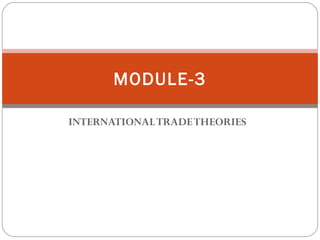This document provides an overview of several theories of international trade, including:
- Mercantilism, which advocated for boosting exports and limiting imports to maintain a trade surplus.
- Absolute advantage theory, which argues that countries should specialize in goods they produce most efficiently.
- Comparative advantage theory, which extends that countries benefit from trade even if they don't have an absolute advantage.
- Heckscher-Ohlin theory and the product life cycle theory examine how differences in factors of production and product maturation influence trade patterns.
Later sections discuss implications of new trade theory, first-mover advantage, Porter's Diamond model of national competitiveness, and implications for business strategy and


































